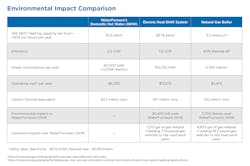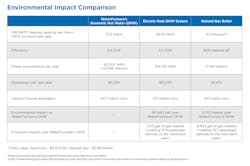Benefits of Removing Gas Hot Water Combustion From Your Building
By RICH CONKLING, Director of Commercial Applications, Engineering and Learning, WaterFurnace International
Decarbonization and electrification of commercial buildings, in both new construction and retrofit applications, continues to gain significant traction among engineers across the globe. The latest trend is to electrify water heating.
Shipments of commercial domestic hot water heaters is proof of this. According to the Air Conditioning, Heating & Refrigeration Institute (AHRI), shipments of electric domestic hot water heaters has grown by roughly 90% since 2001, while shipments of gas units have slightly declined.1 The reason? It’s simple math.
Domestic hot water systems contribute significantly to decarbonization efforts and initiatives for net-zero emissions. For example, a school building that uses a chiller with dedicated heat recovery instead of a boiler can reduce its total natural gas usage by 13%. The carbon footprint can be reduced by as much as 65%. Hot water usage is just as prevalent in these buildings. When you add in the fact that a chiller with dedicated heat recovery can lower your operating costs by 20% as well, it’s easy to see why the trend is taking off.
Collectively, the nearly 100,000 K-12 public schools in the U.S. are one of this country’s largest energy consumers in the public sector.2 They represent roughly 8% of all the energy used in commercial buildings, including as much energy as 43% of all office space nationwide. According to the U.S. Dept. of Energy, schools spend $8 billion on energy annually and emit an estimated 72 million metric tons of carbon dioxide. This is equivalent to the output of 18 coal plants, or more than 8 million homes.3 It’s easy to see why cost and carbon footprint reductions are so important.
And yet, the same logic extends well beyond schools.
This same reduction in cost and carbon footprint can be achieved in almost any commercial building. One of the crucial factors in this equation is the chiller. Ideally, you’ll want to integrate space heating and water heating by choosing a chiller with dedicated heat recovery. As an example, our firm offers a model that recovers heat that is wasted through the cooling tower, or can be integrated into a geothermal ground loop or chilled water system to preheat domestic hot water. Recovering heat within the system significantly increases the overall system efficiency while also eliminating the need for fossil fuels.
While the choice to make this switch is becoming an easy one, sizing is also a key factor to experience maximum savings.
Unlike a gas water heater where oversizing has minimized effects on efficiency and cost, it is extremely important to be cognizant of basic sizing parameters for heat pump water heaters. The goal is to use smaller, less costly units with longer run time and larger tanks to buffer peak demand. The additional storage tank space is less costly than adding heat pumps. With this in mind, we recommend doing the following during the sizing process:
- Determine load by identifying peak demand, daily consumption profiles, and gallons per hour versus flow by fixture;
- Determine storage requirements to meet the peak load and plan accordingly.
The end result is a reduction in energy usage and carbon footprint, all while capturing hot water for nearly no cost.
1 https://ahrinet.org/resources/statistics/historical-data/commercial-storage-water-heaters-historical-data
2 https://www.k12climateaction.org/img/K12-ClimateActionPlan-Complete-Screen.pdf
3 https://www.edweek.org/leadership/it-has-to-be-a-priority-why-schools-cant-ignore-the-climate-crisis/2022/05#:~:text=The%20U.S.%20Department%20of%20Energy,by%20the%20advocacy%20group%20Generation180

